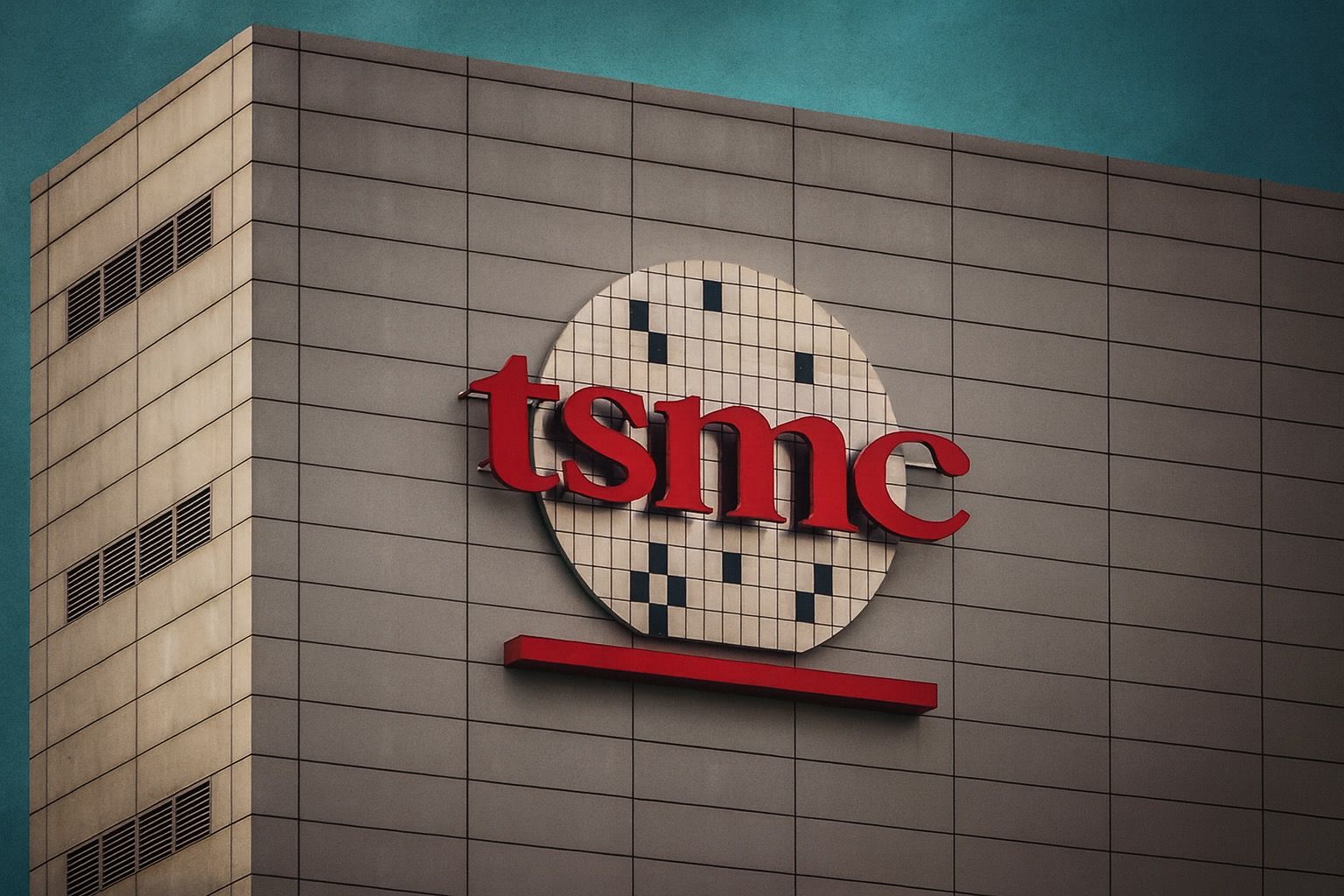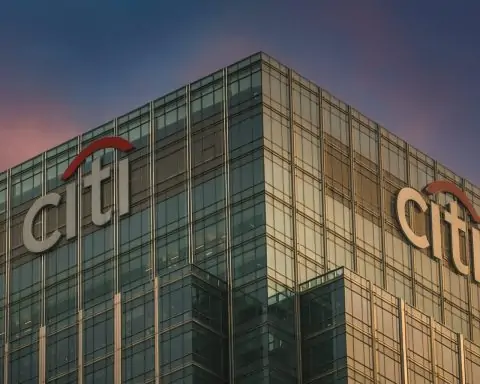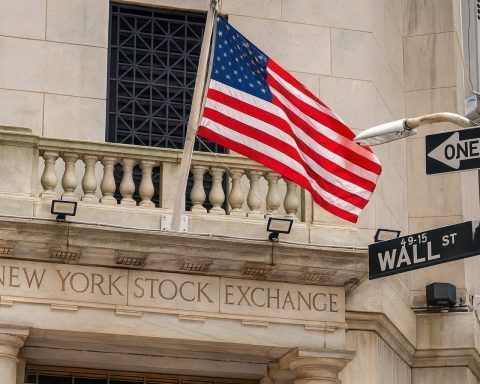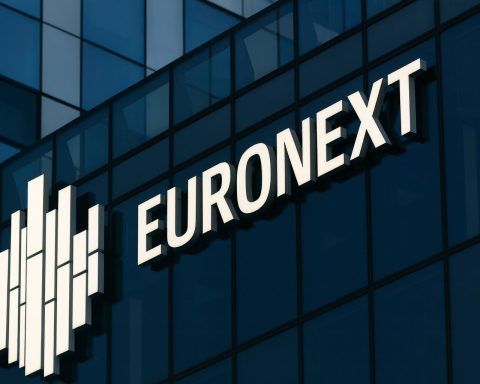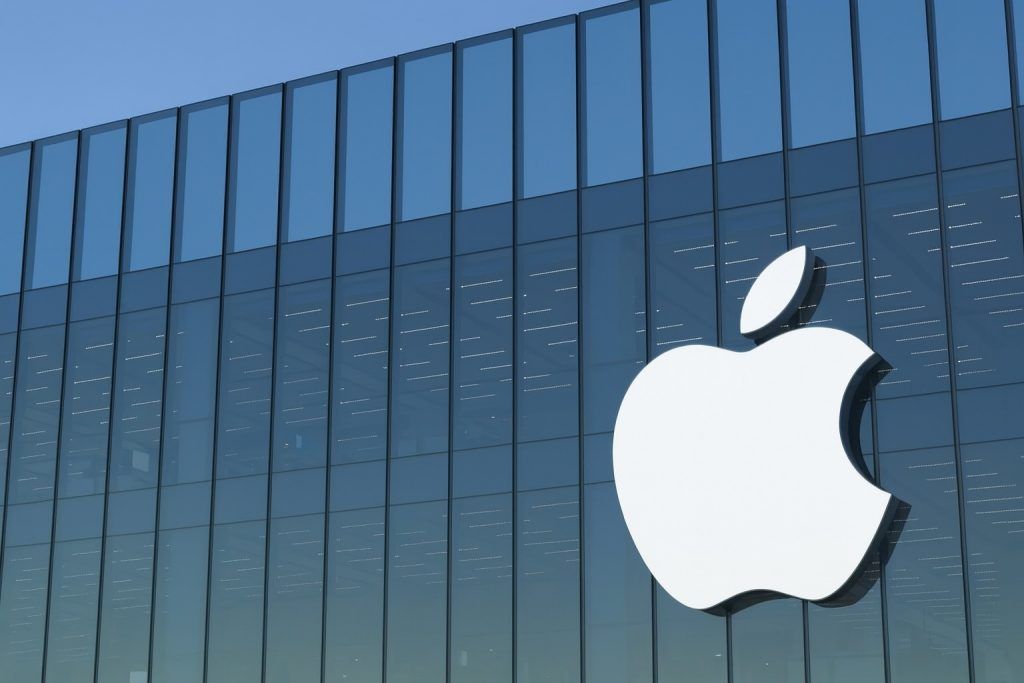- TSMC shares near all-time highs (≈$294) after a record-setting rally fueled by surging AI chip demand and major deals [1]. The stock is up ~45% year-to-date and ~63% over the past year [2].
- Robust financial growth: Q2 2025 revenue jumped +44% YoY to $30.1 billion with strong margins [3]. Management forecasts ~30% full-year growth, and Q3 earnings (due Oct 16) are expected to show 25–30% YoY gains [4].
- Analysts turn bullish: Morgan Stanley urges investors to “accumulate ahead” of a potential guidance boost on Oct 16 amid booming AI demand [5]. Bank of America just hiked its target to NT$1,600 (~$330) citing improved pricing power and 2nm chip momentum [6].
- Geopolitical tensions brewing: Taiwan’s government rejected U.S. calls for a “50-50” chip output split, saying it “never agreed…nor would we” cede half of production to the U.S. [7]. Meanwhile, Chinese military drills spotlight how Taiwan’s fuel supply (97% seaborne) could be choked off [8], prompting Taipei to rethink energy security and Washington to backstop Taiwanese LNG shipments [9].
- AI “supercycle” & tech leadership: Analysts see 32% annual growth in AI chip demand through 2033, positioning TSMC – which leads in cutting-edge 3nm/2nm tech – to capture outsized long-term growth [10]. TSMC is on track to start mass-producing 2nm chips by Q4 2025 and plans a next-gen 1.4nm fab by 2028 [11], keeping it ahead of rivals.
Overview: TSMC’s Business and Recent Performance
Taiwan Semiconductor Manufacturing Co. (TSMC) is the world’s largest contract chipmaker (pure-play foundry), producing advanced semiconductors for clients like Apple, NVIDIA, AMD, and many others [12] [13]. Rather than selling its own branded chips, TSMC builds chips to order, focusing on cutting-edge manufacturing processes. This model has made TSMC a pillar of global tech supply chains and given it an estimated 60%+ market share of the overall foundry market (and over 90% share in the most advanced nodes) [14].
Financially, TSMC has been on a strong growth trajectory. In Q2 2025, TSMC’s revenue reached US$30.1 billion, a 44%year-on-year surge, with net profit of T$398.3 billion, driven by booming orders for high-performance chips [15]. For the first half of 2025, sales totaled about US$60.5 billion [16]. TSMC’s management has guided Q3 2025 revenue in the US$31.8–33 billion range and signaled roughly 30% full-year revenue growth [17] – an impressive clip for a company of its size. Gross profit margins remain very high (mid-50s%), reflecting TSMC’s pricing power and efficient scale. The company plans to invest US$38–42 billion in capital expenditures this year to expand capacity and maintain its technology edge [18].
Business mix: TSMC’s advanced process technologies (like 5-nanometer and 3-nanometer nodes) are in extremely high demand. In fact, cutting-edge 3nm and 5nm chips now account for about 60% of TSMC’s revenue [19]. High-Performance Computing (HPC) chips – used in data centers, AI accelerators, and other computing applications – have rapidly become TSMC’s largest segment, contributing 60% of revenue in Q2 2025, far exceeding the 27% from smartphones [20]. This marks a strategic shift away from mobile devices toward AI/datacenter clients, which include industry leaders like NVIDIA, OpenAI, and Microsoft. TSMC manufactures roughly 90% of the world’s most advanced processors, positioning it at the heart of the AI boom [21]. As one report noted, TSMC’s dominance in 3nm chips and forthcoming 2nm technology keeps it “far ahead” of competitors in the race to power the next generation of AI and high-performance computing [22] [23].
Recent performance: Investor enthusiasm for TSMC has surged alongside its financial growth. The company’s Taipei-listed shares hit a record high of NT$1,370 on Oct 2, 2025 (closing at NT$1,365) [24]. Its U.S.-listed stock (NYSE: TSM) likewise spiked to all-time highs, trading above $290 per share in early October [25]. Year-to-date, TSMC stock has climbed nearly 45% (and over 60% in the past 12 months) as of this week [26] – dramatically outperforming broader market indices. The company’s market capitalization now hovers around NT$35 trillion (over US$1.1 trillion) [27], underscoring its importance as one of the world’s most valuable semiconductor firms. By comparison, the Philadelphia Semiconductor Index is up roughly 36% YTD, indicating TSMC has been a key leader in the sector’s 2025 rally [28].
Current Stock Price and Key Indicators (Oct 8, 2025)
TSMC’s U.S. shares (NYSE: TSM) are trading around $294 on October 8, 2025 – just a few dollars shy of their record closing high. In the past week, TSMC briefly broke above the $300 mark for the first time ever, hitting an intraday high around $307 [29] before a bit of profit-taking. Even at ~$294, the stock is up significantly in recent weeks. For context, TSMC ADRs began the year near $200 and dipped as low as ~$135 at one point in the past 52 weeks [30] [31], so the current level represents a dramatic upswing amid the AI-fueled optimism.
Key market performance metrics for TSMC: the stock’s 52-week range is roughly $134 – $307 [32] [33], and it has gained ~20% just in the past month alone [34]. The rally has pushed TSMC’s valuation multiples upward – for instance, its price-to-book is around 8.1 and enterprise value/EBITDA about 15.2 [35] [36]. TSMC currently trades at roughly 25–30 times projected 2025 earnings (depending on estimates), a reflection of investors’ growth expectations. Despite the high valuation, analyst sentiment is broadly bullish. According to Investing.com data, the average 12-month price target on TSM is approximately $301, with many analysts rating it a “Buy” or equivalent [37] [38]. In Taiwan, local investors have also piled in – TSMC now makes up over 30% of the Taiwanese stock index (TAIEX) by capitalization, and its recent surge singlehandedly pushed the TAIEX to record highs [39].
Other indicators: TSMC offers a modest dividend yield (around 1–2%), and its beta is roughly 1.2 [40], indicating slightly higher volatility than the overall market. Its balance sheet remains strong, with ample cash to fund expansion. All told, at over $1 trillion in market cap, TSMC is firmly in the top tier of global companies – and investors are watching closely to see if it can justify these lofty levels with continued growth.
Recent News Highlights (Late September – Oct 8, 2025)
In the days leading up to October 8, a flurry of significant news has surrounded TSMC – from analyst calls and stock moves to geopolitical developments. Below is a recap of the key headlines affecting TSMC stock:
- 🔺 AI boom drives record rally: TSMC’s share price has been propelled to new heights by the ongoing artificial intelligence boom. On Oct 2, TSMC helped lift Taiwan’s stock market to all-time highs after reports that OpenAI CEO Sam Altman visited Taiwan to meet with TSMC and others about advanced AI chips [41]. A few days later, a blockbuster partnership between OpenAI and AMD (announced Oct 6) sent shockwaves through the chip sector – AMD’s stock skyrocketed ~30% and TSMC, as a key supplier, also jumped [42]. Investors are betting that soaring demand for AI accelerators will keep TSMC’s factories running at full capacity. “Strong demand for AI infrastructure is supporting TSMC,” noted analysts, as TSMC’s cutting-edge 3nm chips are crucial for training AI models [43]. The company has reportedly secured 2nm chip orders from 15 clients (including NVIDIA, AMD, Apple, and more) eager to use its next-gen technology [44] [45]. This AI frenzy has resulted in TSMC’s U.S. shares climbing over 20% in the past month alone [46], briefly valuing the company at more than $1 trillion. Observers described the mood as “euphoric” after TSMC’s stock hit an intraday high of $307 on Oct 7 amid frenzied trading [47].
- 📊 Morgan Stanley’s bullish call: On Oct 7, Morgan Stanley urged investors to “buy TSMC ahead of a guidance boost” expected next week [48]. In a research note, the bank labeled TSMC a “catalyst-driven idea” and predicted the stock “will rise if [TSMC] raises full-year revenue guidance again due to strong AI demand.” Morgan Stanley’s analysts suggested accumulating shares before Oct 16, when TSMC will hold an investor conference alongside its Q3 earnings release [49]. They anticipate TSMC management could upgrade its 2025 sales outlook (currently ~+30% YoY) to +32–34% on the back of booming AI chip orders [50]. The firm also noted that wafer price negotiations for 2026 are trending favorably, and it sees a possible price hike next year given tight advanced-node capacity [51]. Morgan Stanley laid out scenarios: in a bull case TSMC might boost guidance above +35%, which could pop the stock +3–5%; their base case (+32–34% guidance) might add 0–2% to the share price [52]. Even in a cautious scenario (no guidance change), downside is seen as limited (–0 to –5%) [53]. This upbeat call added fuel to the stock’s momentum mid-week.
- 💰 Price target upgrades: Wall Street’s confidence in TSMC has been climbing. Barclays recently raised its price target to $325 (from $275) while reiterating an “Overweight” rating [54]. Analyst Simon Coles at Barclays cited TSMC’s “continued leadership during the AI expansion” and robust performance across business segments, even calling TSMC their “top semiconductor pick.” Similarly, Huatai Securities bumped its target to $320 (Buy rating), noting TSMC’s significant gains in average selling price and profitability, especially since its successful launch of 3nm “N3” chips [55]. Then, on Oct 7, Bank of America Securities (BofA) joined the bull camp – analyst Brad Lin upgraded TSMC’s target price from NT$1,400 to NT$1,600, roughly US$330 per share [56]. BofA cited “an improved pricing outlook and stronger earnings visibility through 2026,” and raised its earnings forecasts for TSMC by ~8–9% for upcoming years [57]. They project a strong ramp-up of 2nm production in 2026, fueling ~24% revenue growth that year [58]. BofA’s note highlighted that 2nm chips could contribute ~9% of TSMC’s revenue as early as 2026, quickly matching the contribution of older 7nm chips [59]. The bank also pointed to rising demand beyond just Apple – including resurgence in non-Apple smartphone chips and continued high-performance computing orders – as drivers for TSMC’s 3nm/2nm business. These analyst endorsements have further validated the market’s optimism around TSMC’s trajectory.
- 🌐 Geopolitical developments: Even as business booms, TSMC finds itself entangled in geopolitical currents. Taiwan–US chip talks made headlines after U.S. officials floated a proposal that Taiwan ensure 50% of chip production happens on American soil – a bid to reduce dependence on Taiwanese fabs. This week, Taiwan’s government flatly rejected the idea. “Our negotiating team has never made any commitment to a 50-50 split on chips…nor would we agree to such conditions,” said Taiwan’s Vice Premier Cheng Li-chiun on Oct 1, following trade talks in the U.S. [60]. Taiwan’s leaders stressed they never even discussed such a provision and that the island intends to keep the bulk of advanced semiconductor production at home [61] [62]. Instead, Taipei is seeking a tariff reduction on tech exports to the U.S. rather than giving in to relocation pressure. This public stance by Taiwan underscores the political sensitivity around TSMC’s location: Washington wants chip capacity onshore for security, while Taiwan views TSMC as a strategic asset tied to its national interests.At the same time, Chinese military activity around Taiwan has raised new concerns. In late September, China conducted large-scale air and naval drills near Taiwan, which reportedly revealed how an island-wide blockade could jeopardize Taiwan’s energy supply [63]. Taiwan relies on imports for 97% of its energy (especially LNG natural gas), nearly all of which arrive by sea. The Wall Street Journal reported that Chinese exercises demonstrated how easily shipping could be disrupted, potentially crippling Taiwan’s power supply and, by extension, chip production [64]. This revelation has prompted Taipei to urgently rethink its energy strategy: the government is now boosting fuel stockpiles and even considering reversing course on nuclear energy (despite having shut its last nuclear reactor earlier this year) [65]. Meanwhile, in Washington, two U.S. senators introduced legislation to support Taiwan’s energy security – including providing insurance guarantees for LNG shipments in the event of a blockade [66].These geopolitical rumblings carry serious implications for TSMC. The company’s cutting-edge fabs require huge amounts of stable electricity and materials; any prolonged disruption to Taiwan’s energy or supply chain routes could impact TSMC’s operations worldwide. Investors have been wary of these risks: notably, famed investor Warren Buffett sold his short-lived stake in TSMC back in 2023, citing geopolitical danger. More recently, hedge fund manager Steve Weiss trimmed his TSMC holdings, bluntly warning that TSMC sits at “ground zero” in a potential China-Taiwan conflict [67]. Such concerns cap enthusiasm to an extent, even as TSMC’s business fundamentals excel.
- 🔧 Tech and expansion updates: On the technological front, TSMC is barreling ahead with next-gen manufacturing. Executives confirmed that mass production of 2-nanometer chips (TSMC’s forthcoming “N2” process) is on track to begin by late 2025 [68]. This will make TSMC the first in the world to reach 2nm volume production, a leap that should cement its process leadership. Industry sources note TSMC already has around 15 customers engaged on 2nm, including about 10 in the high-performance computing realm [69]. NVIDIA’s planned “Rubin” ultra GPU and AMD’s next-gen MI450 accelerators are expected to use TSMC’s 2nm, as are future Apple mobile chips [70]. In preparation, TSMC is phasing out any China-made equipment from its 2nm production lines to ensure eligibility for U.S. subsidies (per CHIPS Act rules) [71]. Looking further out, TSMC has announced a roadmap to build an even more advanced 1.4nm fab in Taichung, Taiwan by 2028, highlighting its commitment to stay ahead of Moore’s Law.In terms of capacity, TSMC’s global expansion continues but with some challenges. In the United States, TSMC is investing heavily to build a semiconductor “GigaFab” complex in Arizona – eventually comprising up to six fabs, two advanced chip packaging plants, and an R&D center [72]. The first phase (two fabs, for 4nm and 3nm production) has faced construction delays and higher costs, pushing initial production to 2025–2026. TSMC responded by flying in experienced engineers from Taiwan to help get the Phoenix fabs on track [73]. Despite the setbacks, TSMC dramatically upped its U.S. commitment in 2025, with total Arizona investment now slated at $40 billion+ (with further expansion to $60B+ possible over 10–15 years) [74]. The company ultimately envisions roughly one-third of its cutting-edge 2nm capacity being located in the U.S. once the Arizona cluster is fully built [75]. Similarly, TSMC is constructing a new fab in Japan (in partnership with Sony) for specialty 28nm/22nm chips, and it just green-lit a €10 billion fab in Dresden, Germany focused on 22nm/16nm automotive chips [76]. These overseas fabs aim to diversify TSMC’s geographic footprint – a buffer against concentration risk – but they come with higher operating costs than in Taiwan [77] [78]. TSMC’s core, including its most advanced R&D and highest-volume fabs, will remain anchored in Taiwan for the foreseeable future, given the island’s established ecosystem and cost advantages [79].
All told, early October 2025 has been an eventful period for TSMC. The stock’s record highs, fueled by concrete AI-driven wins, reflect tremendous optimism. Yet, significant news on the geopolitical front serves as a reminder of the unique risks tied to TSMC’s dominance. Investors are now eagerly awaiting the company’s Q3 earnings report and forecast update on Oct 16, which should shed more light on how TSMC is navigating this high-stakes environment.
Expert Commentary and Analysis
Industry experts and analysts have been weighing in on TSMC’s prospects, generally highlighting the company’s strengths in AI and advanced manufacturing while cautioning about valuation and geopolitical risks. Here are some notable perspectives:
- Analyst bullishness on AI leadership: “TSMC is our top pick in semiconductors,” said Barclays analyst Simon Coles, who in September raised his price target to $325. Coles pointed to TSMC’s “continued leadership during the AI expansion” and the company’s strong execution across business lines [80]. Similarly, Leping Huangof Huatai Securities, who upped his target to $320, noted that TSMC’s average selling prices and profits have surged in recent years thanks to its technological edge in advanced nodes [81]. Many analysts believe the ongoing AI “supercycle” strongly favors TSMC. As brokerage Mitrade summarized, the consensus is that AI chip demand could grow ~32% annually through 2033, and TSMC’s ability to deliver cutting-edge chips ahead of competitors puts it in prime position to capture a large share of this growth [82].
- Morgan Stanley’s take: The Morgan Stanley team has turned decidedly optimistic in the short term. They view TSMC as one of the best plays on AI infrastructure and recommend buying before the upcoming earnings event. “We expect TSMC’s share price to rise if it raises full-year revenue guidance… We suggest accumulating [shares] ahead of October 16,” the bank wrote, citing stronger overall semiconductor demand and a potential 2026 price hike as catalysts [83] [84]. Morgan Stanley also emphasizes TSMC’s rare position as a “must-have” for companies building advanced AI systems – a testament to how indispensable TSMC’s technology has become.
- Executive praise: No one knows the value of TSMC’s capabilities better than its top customers. Jensen Huang, CEO of NVIDIA – whose AI GPUs are all made by TSMC – recently lavished praise on the chipmaker. Huang called TSMC “indispensable” to AI innovation and said investing in TSMC is a “smart” move for those who believe in the future of AI [85]. This sentiment is echoed by many in Silicon Valley: TSMC’s cutting-edge fabs enable the breakthroughs in graphics, AI and mobile chips that power modern tech products. TSMC’s own leadership likes to highlight the deep partnerships it has forged – in some cases co-designing chips with clients to optimize for its process technology [86]. The trust and collaboration between TSMC and firms like Apple and NVIDIA is often cited as a key competitive advantage that rivals struggle to match.
- Valuation and overhangs: Not all experts are universally bullish. Some caution that TSMC’s stock price now reflects a lot of good news. Research firm Simply Wall St noted that, after a ~250% gain over the past five years, TSMC’s valuation looks “moderately overvalued” on certain discounted cash flow metrics [87]. And while CFRA and BofA (prior to its recent upgrade) both had price targets in the high-$200s [88] – suggesting limited upside from current levels – those targets were set before the latest AI-driven rally and may be revised. Macroeconomic factors also play a role: TSMC’s fortunes are tied to global electronics demand, which can be cyclical. The broader chip sector faces some headwinds from higher interest rates and potential peaking of the post-pandemic tech upgrade cycle [89]. If AI hardware investment were to slow or if a global recession hits tech spending, TSMC’s growth could moderate, something a few contrarian analysts point out.
- Geopolitical risk assessments: As discussed, geopolitical issues weigh heavily on TSMC’s risk profile. Several analysts have openly addressed this. The Reuters Breakingviews column has described TSMC’s situation as a “silicon shield” – vital to many countries’ tech needs, yet vulnerable due to its Taiwan-centric production base. Hedge fund manager Steve Weiss (of Short Hills Capital) voiced his concerns bluntly, stating that TSMC is essentially “at ground zero for a possible China–Taiwan conflict.” Even though TSMC is his fund’s largest holding, Weiss trimmed his position to manage this risk [90]. Investors are cognizant that any escalation of cross-strait tensions could send shockwaves through TSMC’s stock. That said, optimists counter that the very importance of TSMC to the global economy might act as a deterrent to conflict – the so-called “too valuable to fail” argument. In any case, analysts generally factor in a geopolitical discount on TSMC’s valuation relative to peers like Samsung or Intel, which operate in less contentious locales.
In summary, the expert consensus on TSMC as of October 2025 is strongly positive on fundamentals – no one doubts the company’s technological prowess or near-term growth – but mindful of external risks. The bull case centers on TSMC’s unmatched leadership in advanced chips (essentially an “arms dealer” of the AI revolution), while the bear case highlights potential pitfalls like geopolitical surprises, execution challenges in new fabs, and high expectations already baked into the stock price.
Market Forecasts and Outlook: Bull vs. Bear Scenarios
With TSMC’s stock at historic highs, what comes next? Market watchers have laid out both bullish and bearish scenarios for the company’s trajectory:
▲ Bullish case: Enthusiasts argue that TSMC is entering an “AI supercycle” that could drive years of above-trend growth. In the optimistic scenario, demand for cutting-edge chips (3nm, 2nm and beyond) accelerates further as artificial intelligence, 5G, and high-performance computing deployments expand worldwide. TSMC’s own customers are booming – for example, NVIDIA’s AI chips are essentially sold out into 2024, and now with AMD striking a multi-billion dollar AI chip deal with OpenAI, the industry is scrambling for more advanced chip capacity [91]. TSMC stands as virtually the only player that can fulfill this demand at the top end. Bulls see TSMC’s revenues compounding strongly through the remainder of the decade, potentially doubling by 2030 if AI, automotive, and IoT continue to proliferate. In this rosy outlook, TSMC’s expansion bets pay off: the Phoenix fabs and other overseas plants come online, allowing TSMC to capture additional business (including possible deals with the U.S. government or defense sector, given onshore capacity). Profitability would remain robust, aided by higher pricing for new nodes – indeed, TSMC has reportedly set 2nm wafer prices ~15–20% higher than 3nm, around $30,000 per wafer [92]. Some analysts have even speculated TSMC could raise prices further in 2026 given its dominance [93] [94].
On Wall Street, recent upgrades reflect this bullishness. As mentioned, Barclays, Huatai, and BofA have all placed targets in the $320–$330 range, implying significant upside from current levels [95] [96]. These targets assume TSMC will continue beating expectations and that the valuation can remain elevated thanks to strong growth and scarcity of alternatives. Morgan Stanley’s bull-case scenario posits TSMC surprising with >35% revenue growth this year, which they believe could pop the stock another 3–5% near term [97]. Long-term bulls see even more room if geopolitical tensions ease: should investors begin to discount less risk for Taiwan, TSMC’s valuation multiples could expand closer to U.S. peer levels (for instance, Intel trades around 18× earnings; TSMC, despite faster growth, has been in the 15–20× range partly due to Taiwan risk).
In short, the bull case envisions TSMC as a foundational winner of the next tech era – akin to an “oil major” of the digital age, supplying the fuel (chips) for AI and computing. If that plays out, TSMC’s stock could continue its upward trajectory, with some aggressive forecasts seeing it reach $350+ in the next 1–2 years (assuming earnings keep outpacing forecasts).
▼ Bearish case: Skeptics, however, urge caution at these heights. The bearish scenario isn’t necessarily a crash, but rather the possibility that TSMC’s growth could moderate or face disruptions, making the lofty stock price hard to justify. One concern is valuation – at ~30× earnings and near $300 a share, a lot of good news is already priced in. Any hint of a slowdown in the semiconductor cycle could trigger a pullback. PC and smartphone markets (about 40% of TSMC revenue combined) are cyclical and have seen soft patches; if AI-related orders (currently driving growth) were to digest or pause, TSMC’s overall sales could disappoint the high expectations. Additionally, some of TSMC’s biggest customers (like Apple) are facing their own market saturation, which could temper chip order growth in certain segments.
Another bearish angle is competition nibbling at the edges. While TSMC is undisputed at the leading edge, competitors are not standing still. Intel is attempting a comeback with its own 18A (≈2nm-class) process by 2025–26, and has even expressed interest in partnering with TSMC (or conversely, competing for similar foundry clients) [98]. Samsung is investing heavily to ramp its 3nm and develop 2nm by 2026, even poaching talent from TSMC. If either competitor closes the gap more than expected, TSMC could face pricing pressure or loss of market share in future nodes. Some analysts warn that Intel and Samsung’s adoption of new high-NA EUV lithography could allow them to narrow the gap by late-decade, though most still expect TSMC to maintain a technological lead of at least a year or two [99].
The biggest wild card in the bear case remains geopolitics and supply chain risk. A direct military conflict over Taiwan, however unlikely day-to-day, would be a worst-case scenario that could severely disrupt TSMC’s operations. Short of that, even a continued atmosphere of tension can hurt: for example, more aggressive U.S. export controls on chip equipment or Chinese retaliation could complicate TSMC’s production plans. It’s telling that TSMC’s U.S. fab project has seen delays and cost overruns – a reminder that replicating TSMC’s efficiency outside Taiwan is challenging [100]. If costs keep ballooning or if the Arizona project hits further snags, TSMC might face margin pressures or dissatisfied customers (some smaller U.S. chip designers have already complained about higher quotes from the Arizona fab). Additionally, Taiwan’s infrastructure issues pose a subtler risk: the island has faced water shortages and now power reliability questions (leading TSMC to install extensive backup systems and even consider on-site power plants). BofA analysts noted that TSMC’s overseas expansion isn’t just about politics – it’s also partly necessitated by “relatively limited [utility] resources in Taiwan”, such as electricity, to support infinite fab growth [101]. Should Taiwan struggle to meet TSMC’s huge power needs, that could cap growth or force costly mitigations.
In the bear case, TSMC’s stock could stagnate or pull back to a lower valuation multiple if growth expectations get dialed down or if investors demand a bigger geopolitical risk premium. For instance, if revenue growth settles to, say, +10% annually after the AI rush, a stock multiple of ~15–20× might be more appropriate – which would imply a stock price closer to $200–$250 (this is just a hypothetical scenario some cautious analysts float). While few see a serious long-term threat to TSMC’s dominance, the combination of “sky-high expectations + unique geopolitical risk” is enough for contrarians to advise some profit-taking after the recent run-up.
Bottom line: The market’s base case still skews positive – TSMC is expected to post very strong Q3 results and likely raise guidance, reinforcing the growth narrative. But there is a balanced debate about upside vs. downside risks at these valuation levels. Investors will be closely watching the upcoming earnings call (and any guidance on 2026 demand or capital spending) to gauge which scenario is more likely.
Semiconductor Industry Trends Impacting TSMC
The broader semiconductor industry’s trends provide important context for TSMC’s outlook. TSMC doesn’t operate in a vacuum; it’s at the center of multiple forces shaping the future of tech manufacturing. Here are a few key industry-wide factors and how they impact TSMC:
1. The AI and High-Performance Computing Supercycle: As noted, an explosion in demand for AI accelerators and advanced computing chips is underway. This is a secular trend, often compared to a new “PC boom” or “smartphone boom” but centered on data centers and AI. Analysts project global AI-related semiconductor revenue to grow at a 32% compound annual rate through 2033 [102], a stunning pace far above traditional chip industry cycles. This rising tide benefits TSMC disproportionately because TSMC builds nearly all the cutting-edge AI chips for firms like NVIDIA, AMD, Amazon (AWS Graviton), etc. In addition, as AI spreads to edge devices (IoT, vehicles, robotics), TSMC’s broad customer base stands to gain. The key for TSMC is to maintain capacity leadership – and so far it has: the company is doubling its AI chip output in 2025 to meet demand [103]. If the AI trend continues unabated, TSMC could enjoy strong order books for years, essentially running its most advanced fabs at full utilization (which is highly profitable). However, it also means TSMC must execute flawlessly on each new node to stay ahead of insatiable demand. Any stumble could cause bottlenecks in the AI supply chain. Right now, TSMC appears to be executing well, and even big AI players like OpenAI and Google are forging strategic ties (visiting Taiwan, considering prepaying for capacity, etc.) to secure their chip supply [104].
2. Supply Chain Diversification and “Tech Sovereignty”: Governments around the world have become acutely aware of the strategic importance of chip manufacturing. This has led to an unusual situation where multiple countries are incentivizing TSMC to set up fabs on their soil – a departure from TSMC’s historically centralized model. The U.S., under its CHIPS Act, is offering subsidies and pushing for more domestic production (hence TSMC’s Arizona fab project). Japan and the EU are similarly rolling out funding to attract fabs. TSMC has responded by cautiously expanding overseas (as detailed earlier). While this diversification helps reduce concentration risk (e.g., not all chips in one basket in Taiwan), it comes at a cost. Overseas fabs are >50% more expensive to build and operate, by some estimates, due to higher labor and construction costs and a less integrated supply chain. TSMC has noted that certain specialty materials and equipment suppliers are still mostly in Asia, meaning that duplicating the whole ecosystem abroad is challenging [105]. For example, TSMC relies on Japanese suppliers for advanced photoresist chemicals and on Dutch firm ASML for lithography machines; getting these to Arizona or Germany in time and in volume is a logistical hurdle. Additionally, TSMC’s culture and processes are deeply rooted in Taiwan – when it tried to ramp up 5nm in Arizona with local workers, unexpected inefficiencies occurred, prompting TSMC to send over veteran engineers from Taiwan [106]. TSMC’s leadership has made clear that Taiwan will remain the primary manufacturing base, especially for the most advanced R&D and production, with overseas plants serving as satellite capacity [107]. In effect, while diversification is ongoing, it will likely cap out at perhaps 20–30% of TSMC’s total capacity offshore. Industry observers believe this hybrid model is the new normal: more geographic spread for political reasons, but continued reliance on the dense Taiwanese cluster for core technology.
3. Competition and Collaboration in Leading-Edge Tech: TSMC’s main competitors in leading-edge foundry are Samsung (South Korea) and increasingly Intel (USA, as it retools for foundry business). Both competitors are investing tens of billions to try to catch up to TSMC’s process technology. Samsung was first to 3nm (with a gate-all-around transistor design), but it struggled with yields, and TSMC’s 3nm has been more successful commercially. Samsung and TSMC are now racing to 2nm around 2025–2026. Intel, under its IDM 2.0 strategy, is also aiming to regain process leadership by 2025 and attract external fabless customers. They’re deploying next-gen High-NA EUV lithography machines and have outlined an aggressive roadmap (Intel 20A, 18A) to essentially tie with TSMC’s 2nm timeline [108]. Many analysts, however, remain skeptical that Intel or Samsung can meaningfully erode TSMC’s lead in the next 2–3 years [109]. TSMC’s decades of experience in high-volume manufacturing and its close partnerships with design leaders give it an edge that is hard to replicate. Furthermore, rather than a zero-sum game, we’re seeing new forms of collaboration: Intel has reportedly explored outsourcing some chip production to TSMC (for GPUs or certain SoCs), and even MediaTek (a mobile chip rival to Qualcomm) has agreed to have some chips made at Intel’s foundry in the future – possibly in exchange for Intel partnering with TSMC in Arizona [110]. These complex dynamics mean TSMC might simultaneously compete with and supply to companies like Intel. For instance, Intel’s upcoming GPU chips are made by TSMC even as Intel tries to rival TSMC’s core business. Net effect: TSMC is likely to remain the top player, but it operates in a landscape where major tech firms and governments are highly motivated to close the gap. Close attention is paid to each new node’s progress – if Samsung’s 2nm or Intel’s 18A were to hit a breakthrough or, conversely, a setback, it would influence how much business TSMC can capture. So far, TSMC’s track record of execution and customer trust has kept it the foundry of choice for leading chip designers [111].
4. Regulatory and Geopolitical Crosswinds: The semiconductor industry is heavily impacted by government policies, and TSMC sits at the intersection of U.S.-China-Taiwan relations. Several ongoing issues are shaping the environment:
- Export controls: The U.S. has imposed restrictions on chip exports to China (especially high-end AI chips) and on the transfer of certain chipmaking technologies. TSMC complies with these, meaning it cannot sell its most advanced chips to Chinese firms like Huawei’s HiSilicon without a license. There are also U.S. rules that could bar TSMC from installing equipment in new Chinese fabs. While TSMC’s main business is with U.S. customers, China still accounts for ~10% of TSMC’s revenue [112] (mostly less-advanced chips). Tightening export rules could impact that segment and force TSMC to rejig some capacity allocation.
- CHIPS Act subsidies: TSMC is applying for U.S. subsidies for its Arizona fabs, but these come with strings attached – limits on expanding in China, profit-sharing clauses above certain margins, etc. TSMC has voiced some hesitancy about the terms. It’s also why TSMC is removing Chinese-made equipment from its Taiwan facilities that will produce 2nm, to ensure those fabs could qualify for U.S. subsidy support if needed [113]. The interplay of subsidies and tech restrictions is a delicate dance for TSMC as it tries to maximize support from multiple governments without alienating any.
- Tariffs and trade deals: The ongoing U.S.–China trade war also affects TSMC indirectly. Notably, the U.S. tariffs on many Chinese goods (including some tech components) were temporarily reduced or paused through Nov 2025 [114]. This gives a short-term breather to chip supply chains [115]. Meanwhile, Taiwan is seeking a free-trade agreement with the U.S. that could remove a 25% tariff on its tech exports [116]. If that happens, TSMC (which exports billions of dollars of chips to American companies) would benefit from lower costs. Conversely, any deterioration in U.S.-China relations could prompt China to retaliate in ways that might affect TSMC – for example, by restricting exports of critical minerals or equipment that TSMC needs (China is a major supplier of raw materials like silicon wafers and certain chemicals).
- Political stability in Taiwan: The industry keeps a watch on Taiwan’s domestic situation too. Taiwan has a presidential election in early 2024, and any shift in cross-strait policy could have implications. However, TSMC historically has enjoyed bipartisan support in Taiwan – it’s seen as the crown jewel of the economy. The company itself stays apolitical outwardly, focusing on business.
In summary, TSMC’s operating environment is shaped by more than just supply and demand – it’s also about navigating an unprecedented level of government involvement and international scrutiny. The company’s strategy has been to engage constructively: invest in key countries, comply with regulations, and continuously emphasize that keeping TSMC successful benefits everyone. This is generally true; for instance, one analysis noted that a disruption to TSMC would cost the global electronics industry hundreds of billions and set back technological progress. That reality underpins why many say TSMC provides a “silicon shield” for Taiwan – it’s in the world’s interest to keep Taiwan safe and TSMC running [117].
New Tech Developments and Supply Chain Factors
As a technology leader, TSMC is constantly pushing the frontier of chip manufacturing. Here are some new developments on the technology and supply chain front that are particularly relevant as of October 2025:
- 2nm Process Ramp-Up: TSMC’s next big leap is the transition to 2-nanometer production, slated to begin high-volume manufacturing by Q4 2025 [118]. This node (N2) will likely debut in products around 2026 and is expected to bring substantial improvements in power efficiency and performance. TSMC has built new facilities in Hsinchu and southern Taiwan (Kaohsiung) for 2nm, and construction is nearly complete. According to industry reports, about 15 early customers are engaged with TSMC on 2nm, and around ten of those are in high-performance computing domains [119]. This includes familiar names: Apple (likely reserving 2nm for its A-series and M-series chips by 2026), NVIDIA (for its next-gen GPUs), AMD (for CPUs/APUs and accelerators), and even Intel, which some speculate might use TSMC 2nm for certain chiplet components of its processors. Achieving a smooth ramp at 2nm is crucial for TSMC to maintain its technology leadership – any delay or yield issue could open a window for competitors. As of now, TSMC reports that development is on schedule. In fact, the company is so confident that it has already roadmapped a “N2P” enhanced 2nm node in 2026 and a 1.4nm node by 2028, showing a clear pipeline of innovation [120].
- Advanced Packaging and Chiplet Innovation: Beyond transistor shrinkage, TSMC is innovating in chip packaging technologies, which are increasingly important in the chip industry. The company’s 3DFabric family (including CoWoS and InFO packaging) allows multiple chiplets to be integrated in advanced ways. This has been pivotal for AI chips – for instance, NVIDIA’s highest-end GPUs use CoWoS (Chip-on-Wafer-on-Substrate)technology from TSMC to stitch HBM memory and logic together. Demand for CoWoS has been so high in 2023–2025 that TSMC’s packaging facilities were reportedly at full capacity. TSMC is investing to roughly double its advanced packaging capacity by 2025 to alleviate bottlenecks [121]. Additionally, TSMC is collaborating with EDA companies like Cadence and Synopsys to enable 3D chip design workflows, and it’s working with partners on new chiplet standards. The goal is to offer customers not just silicon fabrication but also state-of-the-art integration techniques. This end-to-end capability is increasingly a differentiator – effectively, TSMC is becoming a one-stop shop for complex system-on-chip assembly.
- Supply Chain Resilience Measures: In light of global uncertainties, TSMC has taken steps to bolster its supply chain resilience. The company has built up higher inventory of critical materials (like silicon wafers, industrial gases, and chemicals) to guard against disruptions. It has also diversified its supplier base where possible – for example, qualifying multiple vendors for key equipment whenever feasible. However, some dependencies are hard to mitigate: ASML of the Netherlands remains the sole provider of EUV lithography machines, which are critical for TSMC’s leading-edge production. TSMC works closely with ASML (even investing in the company) to secure capacity. On the materials side, Japan supplies many photoresists and specialty chemicals; TSMC has supported Japanese suppliers setting up local Taiwan operations to shorten the supply chain. A notable initiative is TSMC’s investment in gigantic water recycling facilities at its fabs after a drought in 2021 highlighted water risk. TSMC now can reclaim a large portion of water used in fabrication, aiming for over 90% reuse in some fabs. This helps insulate it from water shortages (a potential weapon China could use by diverting rainfall or etc., in a worst case). Likewise, facing electricity concerns, TSMC has implemented extensive backup power solutions and is a big purchaser of renewable energy in Taiwan to both improve sustainability and energy security. Just two weeks ago, TSMC even launched a new power-saving initiative across its fabs to cut energy use by 5% without affecting output [122], indicating how seriously it’s treating the power supply issue.
- Logistics and Export Adaptations: With the world carved into blocs for tech, TSMC is adjusting its workflows. It now must ensure that any tools it ships to its China fabs (which make older chips) don’t include cutting-edge tech, per U.S. export rules. The company set up stricter controls and audits for its equipment moves. Conversely, TSMC is prepared to swiftly comply with any new U.S. rules to receive subsidies. For example, new U.S. rules might require that chips made with U.S. subsidies aren’t sold to certain countries – TSMC would route production accordingly. The company also keeps production nimble to react to export license delays (like when some Chinese orders were put on hold pending U.S. approvals). So far, TSMC’s broad customer base allows it to reshuffle production if needed – e.g., if one region softens due to controls, demand from elsewhere can fill the gap. But this requires tight coordination in its supply chain and customer communications.
All these technological and supply chain efforts underscore that TSMC is both a tech innovator and a logistics powerhouse. The company’s ability to simultaneously push the envelope of Moore’s Law and handle geopolitical turbulence is being tested like never before. By most accounts, TSMC is performing admirably on both fronts – it continues to deliver cutting-edge chips (Apple’s latest A17 Pro in 2025 iPhones is 3nm made by TSMC, etc.) and has avoided any major supply disruptions despite pandemic and trade-war challenges. The next few years will likely bring more such tests, but TSMC’s proactive approach – from localizing critical R&D in Taiwan to expanding footprints abroad – suggests it is trying to cover all bases.
Conclusion
As of October 2025, Taiwan Semiconductor Manufacturing Company finds itself in a pivotal position. The company is thriving amid an AI-driven boom, with demand for its most advanced chips at unprecedented levels and its stock price near record highs [123]. TSMC’s upcoming 2nm technology and global expansion plans promise to keep it at the forefront of the semiconductor industry for years to come. Financially, the firm is delivering strong growth and is expected to post another quarter of impressive results on Oct 16 [124], reinforcing its status as a tech powerhouse.
Yet, this success comes bundled with significant challenges and risks. TSMC’s dominance has made it perhaps the most geopolitically exposed company on the planet – a “hot commodity” in the tug-of-war between superpowers. The specter of U.S.–China tensions looms over its Taiwan operations, and even as TSMC mitigates risk by building fabs abroad, those projects face their own hurdles in cost and execution. Investors are essentially weighing TSMC’s unparalleled technological and market strengths against the macro and geopolitical uncertainties inherent in its situation [125]. It’s a complex equation: on one hand, TSMC’s technical roadmap and client pipeline suggest years of growth (making it a linchpin of AI and computing globally); on the other hand, unpredictable external events could impact that trajectory at any time.
For now, most signs point to TSMC continuing its momentum into 2026. The next few months will be crucial – the company’s Q3 earnings and investor call will give an updated read on demand, and any guidance changes (as Morgan Stanley anticipates) could move the stock. Additionally, updates on 2nm production progress and capacity expansion will be closely watched to ensure TSMC’s growth can be sustained [126]. On the geopolitical front, dialogues like Taiwan’s trade talks with the U.S. or any easing/tightening of tech export policies could alter sentiment around TSMC.
In conclusion, TSMC stands at a crossroads of innovation and geopolitics in late 2025. The company’s execution in coming quarters – both in the fab and in navigating political waters – will determine whether its stock’s stellar run can continue. Given TSMC’s track record, few would bet against this silicon giant, but the company’s leadership certainly isn’t taking anything for granted. As CEO C.C. Wei often reminds stakeholders, “We earn our customers’ trust one chip at a time.” That relentless focus will be essential for TSMC to justify the market’s confidence and to remain, as NVIDIA’s CEO put it, the indispensable force behind the world’s AI aspirations [127].
Sources: Taiwan News [128] [129] [130]; Reuters [131] [132]; Benzinga/WSJ [133] [134]; ts2.tech (Tech Trends) [135] [136] [137] [138]; Investing.com [139] [140]; Capital.com [141] [142]; Simply Wall St [143]; SemiWiki/HPCwire via ts2.tech [144]; TSMC Investor Relations [145]; Morgan Stanley via Investing.com [146]; Barclays via Futubull/Capital.com [147]; Bank of America via Investing.com [148].
References
1. www.benzinga.com, 2. ts2.tech, 3. ts2.tech, 4. ts2.tech, 5. www.investing.com, 6. www.investing.com, 7. www.reuters.com, 8. www.benzinga.com, 9. www.benzinga.com, 10. ts2.tech, 11. ts2.tech, 12. www.taiwannews.com.tw, 13. ts2.tech, 14. ts2.tech, 15. ts2.tech, 16. ts2.tech, 17. ts2.tech, 18. ts2.tech, 19. www.taiwannews.com.tw, 20. www.taiwannews.com.tw, 21. www.taiwannews.com.tw, 22. www.taiwannews.com.tw, 23. ts2.tech, 24. www.taiwannews.com.tw, 25. www.taiwannews.com.tw, 26. ts2.tech, 27. www.taiwannews.com.tw, 28. ts2.tech, 29. www.macrotrends.net, 30. www.investing.com, 31. www.investing.com, 32. www.investing.com, 33. www.macrotrends.net, 34. ts2.tech, 35. www.investing.com, 36. www.investing.com, 37. www.investing.com, 38. www.investing.com, 39. www.taiwannews.com.tw, 40. www.investing.com, 41. www.taiwannews.com.tw, 42. www.benzinga.com, 43. www.taiwannews.com.tw, 44. www.taiwannews.com.tw, 45. ts2.tech, 46. ts2.tech, 47. www.macrotrends.net, 48. www.investing.com, 49. www.investing.com, 50. www.investing.com, 51. www.investing.com, 52. www.investing.com, 53. www.investing.com, 54. capital.com, 55. capital.com, 56. www.investing.com, 57. www.investing.com, 58. www.investing.com, 59. www.investing.com, 60. www.reuters.com, 61. www.reuters.com, 62. www.reuters.com, 63. www.benzinga.com, 64. www.benzinga.com, 65. www.benzinga.com, 66. www.benzinga.com, 67. ts2.tech, 68. ts2.tech, 69. ts2.tech, 70. ts2.tech, 71. ts2.tech, 72. ts2.tech, 73. ts2.tech, 74. ts2.tech, 75. ts2.tech, 76. ts2.tech, 77. ts2.tech, 78. ts2.tech, 79. ts2.tech, 80. capital.com, 81. capital.com, 82. ts2.tech, 83. www.investing.com, 84. www.investing.com, 85. ts2.tech, 86. ts2.tech, 87. ts2.tech, 88. ts2.tech, 89. capital.com, 90. ts2.tech, 91. www.benzinga.com, 92. fudzilla.com, 93. www.investing.com, 94. www.investing.com, 95. capital.com, 96. www.investing.com, 97. www.investing.com, 98. www.taiwannews.com.tw, 99. ts2.tech, 100. ts2.tech, 101. www.investing.com, 102. ts2.tech, 103. ts2.tech, 104. www.taiwannews.com.tw, 105. ts2.tech, 106. ts2.tech, 107. ts2.tech, 108. ts2.tech, 109. ts2.tech, 110. ts2.tech, 111. ts2.tech, 112. www.taiwannews.com.tw, 113. ts2.tech, 114. ts2.tech, 115. ts2.tech, 116. www.reuters.com, 117. ts2.tech, 118. ts2.tech, 119. ts2.tech, 120. ts2.tech, 121. ts2.tech, 122. www.taiwannews.com.tw, 123. ts2.tech, 124. ts2.tech, 125. ts2.tech, 126. ts2.tech, 127. ts2.tech, 128. www.taiwannews.com.tw, 129. www.taiwannews.com.tw, 130. www.taiwannews.com.tw, 131. www.reuters.com, 132. www.reuters.com, 133. www.benzinga.com, 134. www.benzinga.com, 135. ts2.tech, 136. ts2.tech, 137. ts2.tech, 138. ts2.tech, 139. www.investing.com, 140. www.investing.com, 141. capital.com, 142. capital.com, 143. ts2.tech, 144. ts2.tech, 145. ts2.tech, 146. www.investing.com, 147. capital.com, 148. www.investing.com
